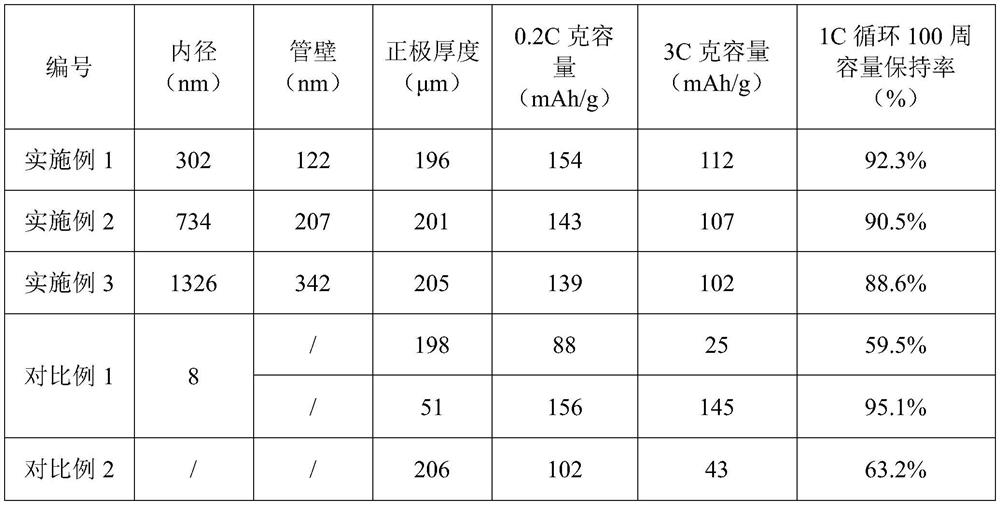Conductive composite material, preparation method thereof and application of conductive composite material in lithium ion battery electrode
A conductive composite material and conductive polymer technology, applied in battery electrodes, secondary batteries, secondary battery repair/maintenance, etc., can solve battery safety performance and cycle performance deterioration, increase lithium ion transmission path, and pole piece porosity The reduction of the rate and other problems, to achieve the effect of good conductivity, good ion conduction ability, and good conductivity
- Summary
- Abstract
- Description
- Claims
- Application Information
AI Technical Summary
Problems solved by technology
Method used
Image
Examples
Embodiment 1
[0043] A method for preparing a conductive composite material is provided, specifically comprising the steps of:
[0044] Step 1. Add polymethyl methacrylate and conductive carbon black into the organic solvent N,N-dimethylformamide, heat and stir at 40°C for 6 hours, and prepare polymethyl methacrylate and conductive agent with a concentration of 5 % electrospinning solution A, wherein the mass ratio of conductive agent to polymethyl methacrylate is 0.1:1. Electrospinning equipment was used to set the voltage at 10kV, the spinning rate at 100mL / min, and the electrode distance at 30cm, and electrospin the solution A to obtain nanofibers with a diameter of 302nm.
[0045] Step 2. Add the nanofibers obtained in step 1 into the 1mol / L hydrochloric acid solution of aniline, the mass ratio of aniline and nanofibers is 0.8:1, stir at 500 rpm for 6 hours, and the nanofibers are evenly dispersed to obtain mixed liquid B ;
[0046] Step 3. Add ammonium sulfate to the mixed liquid B obt...
Embodiment 2
[0049] A method for preparing a conductive composite material is provided, specifically comprising the steps of:
[0050] Step 1, adding polystyrene and conductive agent carbon nanotubes into the organic solvent dimethyl furan, heating and stirring at 60°C for 3 hours, and preparing an electrospinning solution A with a polystyrene and conductive agent concentration of 10%, the conductive agent and The mass ratio of polystyrene is 0.2:1. Electrospinning equipment was used to set the voltage at 20kV, the spinning rate at 60mL / min, and the electrode distance at 20cm, and electrospin the solution A to obtain nanofibers with a diameter of 734nm.
[0051] Step 2, adding the nanofibers obtained in step 1 into a 1mol / L hydrochloric acid solution of pyrrole, the mass ratio of pyrrole and nanofibers is 0.9:1, stirring at 1000 rpm for 4 hours to obtain a mixed liquid B;
[0052] Step 3, add hydrogen peroxide to the mixed liquid B obtained in step 2, the mass ratio of pyrrole to hydrogen...
Embodiment 3
[0055] A method for preparing a conductive composite material is provided, specifically comprising the steps of:
[0056] Step 1, adding polyvinyl acetate and conductive agent graphene into the organic solvent N-methylpyrrolidone, heating and stirring at 100°C for 1 hour, and preparing an electrospinning solution A with a concentration of polyvinyl acetate and conductive agent of 20%, conductive The mass ratio of agent to polyvinyl acetate is 0.3:1. The electrospinning equipment was used to set the voltage at 30kV, the spinning rate at 20mL / min, and the electrode distance at 15cm, and electrospin the solution A to obtain nanofibers with a diameter of 1326nm.
[0057] Step 2, adding the nanofibers obtained in step 1 into a 1mol / L hydrochloric acid solution of thiophene, the mass ratio of thiophene and nanofibers is 1:1, stirring at 2000 rpm for 2 hours to obtain a mixed liquid B;
[0058] Step 3: Add ferric chloride to the mixed liquid B obtained in step 2, the mass ratio of t...
PUM
| Property | Measurement | Unit |
|---|---|---|
| thickness | aaaaa | aaaaa |
| diameter | aaaaa | aaaaa |
| diameter | aaaaa | aaaaa |
Abstract
Description
Claims
Application Information
 Login to View More
Login to View More - R&D
- Intellectual Property
- Life Sciences
- Materials
- Tech Scout
- Unparalleled Data Quality
- Higher Quality Content
- 60% Fewer Hallucinations
Browse by: Latest US Patents, China's latest patents, Technical Efficacy Thesaurus, Application Domain, Technology Topic, Popular Technical Reports.
© 2025 PatSnap. All rights reserved.Legal|Privacy policy|Modern Slavery Act Transparency Statement|Sitemap|About US| Contact US: help@patsnap.com


